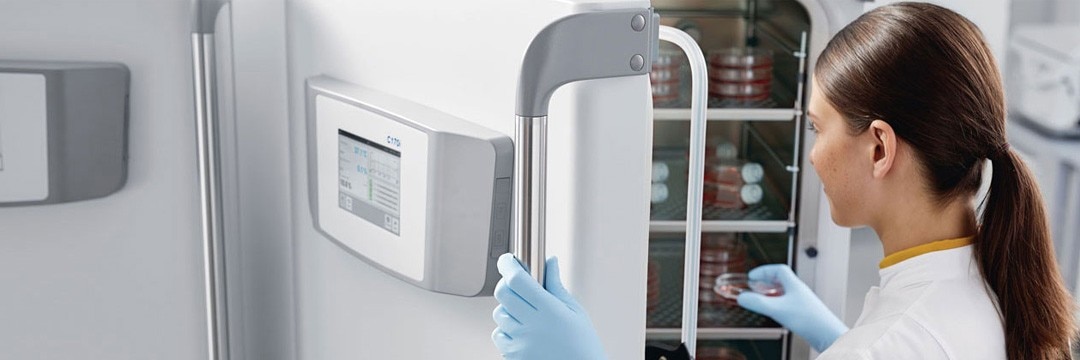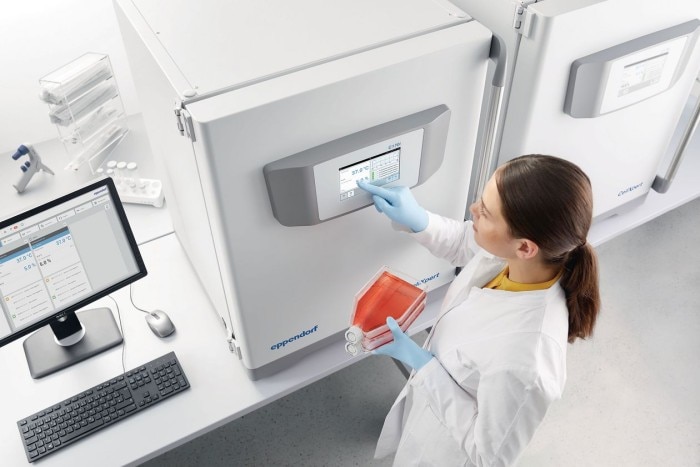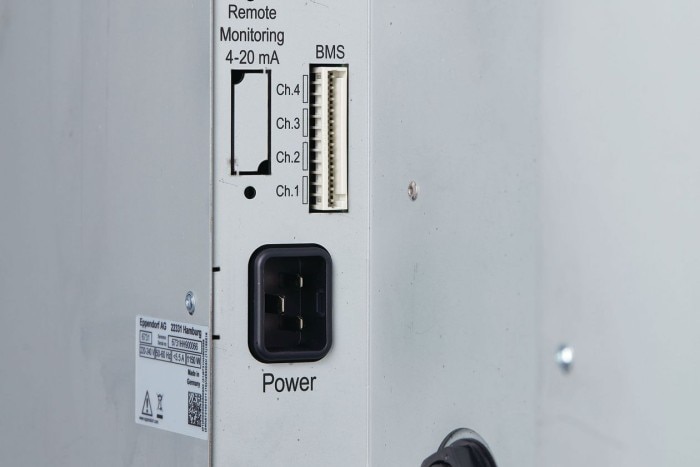-
- Wszystkie wirówki
- Wirówki stołowe
- Wirówka stojąca na podłodze
- Wirówki z chłodzeniem
- Mikrowirówki
- wirówki wielofunkcyjne
- Wirówki wysokoobrotowe
- Ultrawirówki
- Koncentrator
- IVD Products
- High-Speed and Ultracentrifuge Consumables
- Probówki wirówkowe
- Płytki wirówkowe
- Zarządzanie urządzeniem
- Zarządzanie próbkami i informacjami
-
- Wszystkie pipety, dozowniki i stacje robocze do automatycznej obsługi cieczy
- Pipety mechaniczne
- Pipety elektroniczne
- Pipety wielokanałowe
- Pipety i dozowniki wyporowe
- Końcówki
- Dozowniki butelkowe
- Pipetory
- Akcesoria do dozowników i pipet
- Automatyczne pipetowanie
- Materiały zużywalne do automatyzacji
- Akcesoria do automatyzacji
- Usługi związane z dozownikami i pipetami
Cell Culture Ergonomics - Eppendorf PhysioCare Concept®
Przeczytaj mniej

Cell culture is physical work
Culture flasks need to be transferred from the CO2 incubator to the biosafety cabinet, the medium needs to be changed, cells to be microscoped, and finally all flasks are transferred back to the CO2 incubator. This workflow includes a variety of ergonomic aspects to be considered. Keep in mind, you may spend hours for cell culture work. 4 hours at the bench count for your back. This means the workflows you have in your lab should form the starting point for the lab’s design, especially when setting up a new cell culture lab.
Przeczytaj mniej
Przeczytaj mniej
Kneeling in front of your incubator?
Due to lack of space, CO2 incubators are quite often stacked in labs. The upper unit is easy to reach whereas you need to bend forward or even kneel to reach the lower unit.
CO2 incubators should be located on the lab bench to reduce the physical stress experienced by the scientists and lab workers who handle cell cultures.

Spending hours cleaning the corners?
The CO2 incubator is the heart of your cell culture. One of the most threatening situations for your cells is contamination within the incubator.
To reduce this risk, the inner chamber is regularly cleaned. The welding seams of classic incubators are a potential cluster of microorganisms and difficult to clean.
Welding-free incubator chambers are far easier to clean.

Ripped your glove on the metal closure?
The sharp edges of classic metal closures are a constant threat to your gloves. The magnetic closure concept provides an easy and comfortable opening and closure mechanism.

Struggling with cables?
Do you have to turn the incubator to the left and right just to get everything plugged in? 100 kg can get very heavy…
To make connecting the device as easy as possible, all cable interfaces should be located at one corner of the incubator to provide a convenient access.

Who knows how to…?
Standard labs use a broad range of different instruments. Every instrument has a different kind of interface. Interaction needs to be learned.
Standardized user interfaces make handling of different devices as easy as possible. You know one, you know all. Equipment touchscreens should provide an intuitive arrangement of all information.

Looking for the data port?
Quite often, the data port is hidden at the back of the instrument. As a result, you think twice if you want to blindly poke around with your flash drive at the back of the instrument to find the data port.
Easy and logical location of the data port at the front of the instruments makes data export as easy as possible.

Can I still use this half-way wrapped dishes?
Remember the last time you opened the storage compartment for cell culture consumables and facing a half-way used package of dishes which were not properly packed anymore? Plastic wrap tend to re-open after the original seal is broken.
Resealable and shrinkable packaging bags enable a proper, easy, and reliable repack of the remaining cell culture consumables. Less need to throw away half-used packages due to potential contamination and space-saving by very compact wrappings.

Was it the 5th or the 6th well in the third row when the phone rang?
Did the fifth well in the third row now already get the enzyme or not? When in a hurry, people forget details if these are not clearly marked.
The high-contrast alphanumeric labeling of the wells support better and faster well identification and therefore reducing pipetting errors.

Remember the last time you moved the pile of dishes and missed the lowest dish?
Classic cell culture dishes have narrow rims. After you’ve stacked five or ten cell culture dishes, you try to grab them at once for relocation to the CO2 incubator. Chances are high that you’ll miss the lowest one.
The corrugated handling ring provides extra safety when handling and transporting cells in culture dishes. Bring them all home safely.

Do rolling caps get on your nerves?
When conducting cell culture work within a biosafety cabinet, many user remove the lids of the cell culture flasks and place them upright on the bench surface to reduce the risk of contamination.
As many of these caps are round, they tend to roll away. Antirolling caps are corrugated to avoid this effect – they keep the cap right where you put it.

Why is this the 5 mL and not the 10 mL version?
Serological pipettes volume sizes for cell culture look quite similar: a plastic bag with sealed long pipettes, tiny printing and likewise diameters.
The volume-specific color-coding of the serological pipettes enables you to select the correct volume at the bench right away. This is supported by their wrapping as well. This translates into fewer mistakes and less stress during cell culture work.

Annoyed by this pile of bulky and worn out bags with serological pipettes?
Serological pipettes are commonly bagged in packages of 50 or 100 pieces. Storing these bags near the cell culture bench takes up far too much space, increases the risk of contamination, complicates selecting the correct volume and, of course, looks messy.
Special packaging boxes enables easy opening and access to the pipettes.

Przeczytaj mniej
